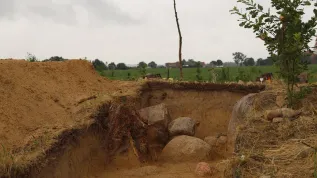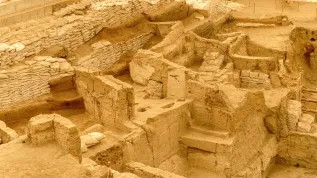
Krzemionki - Neolithic flint mines in the province Świętokrzyskie are on the Polish Tentative List created by the World Heritage Committee in Poland. This is another step to including the site on the prestigious UNESCO World Heritage List.
"Museum has been making efforts for many years for the nomination of Krzemionki to the prestigious group of sites on the UNESCO list. But this process is lengthy and complex, it requires a comprehensive and forward-looking approach to the site" - reads the release sent by the Archaeological Museum and Reserve "Krzemionki".
The mines in Krzemionki were active during the Neolithic and Early Bronze Age (c. 3900-1600 BC). Shafts and heaps are preserved in good condition to this day, allowing to study some of the prehistoric flint mining techniques. The obtained flint was used to produce tools that archaeologists continue to find within a radius of 600 km from the mines. Reconstruction of a prehistoric settlement was built near the mine complex in 1991.
Due to the unique scientific value, in 1994 Krzemionki received the official status of Historic Monument, and since 1995 the site is also a natural reserve.
"Putting Krzemionki on the Polish Tentative List is a huge first step on the road to UNESCO. The site, which is seeking to be nominated, must meet a number of conditions - primarily prove its uniqueness compared to other similar sites in the country, Europe and the world "- reads the museum release.
Now the museum must demonstrate an appropriate level of protection and management of the monument, and the appropriate level of funding adequate to the importance of the site and ensuring its proper functioning. At the end of this road, it will be added to the prestigious UNESCO World Heritage List, next to Memphis and its pyramids in Egypt and Angkor Wat temple complex in Cambodia. This will not only confirm its uniqueness, but also guarantee exceptional protection and international promotion.
Inclusion on the Tentative List was made possible by many years of efforts of the museum, and the support and cooperation with the National Heritage Institute and the Ministry of Culture and National Heritage.
The next step will be the evaluation by the International Council on Monuments and Sites (ICOMOS) and possible recommendation to the UNESCO World Heritage Committee, which makes the final decision. Curators hope that Krzemionki will be inscribed on the list in a few years. The list currently contains about 800 cultural and 200 natural heritage sites.
PAP - Science and Scholarship in Poland
szz/ ula/ mrt/
tr. RL













